DAMS Project
PROJ6003 Project Execution and Control
Assessment Case Study
Department Asset Management System – DAMS Project
Background
The organization is a large state-based government department in Victoria with assets and stakeholders throughout the entire state of Victoria. This project is to deliver an Asset Management Information System which will store the details of all new and existing assets, which include land and buildings across multiple locations. We will call the system DAMS, Departmental Asset Management System. The DAMS System replaces over 20 department asset management systems and manual processes, including systems written in MS Access, Excel, and Lotus Notes. Due to the number of assets and divisions within the department, it was decided that the system would be developed and deployed over a three-year period, with three separate deployments.
The project was purchased on the basis of responses to a tender, and the successful supplier was an experienced vendor, who had previously delivered this application to other state government-based agencies. We will call the vendor Great IT Systems (GIS). The contract was approved as a fixed price contract, using the Requirements Specification document from the Tender as the agreed basis for costing. The contract allows for changes to specifications and requirements at a fixed hourly rate according to the rate card.
The CoTS (Commerical Off the Shelf) software solution was purchased for a cost of $5.5M plus implementation and training costs. Training development and delivery were quoted at a cost of 500 days at a daily rate of $1000 per day. Implementation costs, including requirements analysis, customization, and system testing were charged at $3M. Hardware and infrastructure were purchased at a cost of $4.5M. The total cost of the project is recorded as lifecycle cost, which includes ongoing maintenance during the life of the program, generally made up of the initial contract plus two extensions of the initial contract. Changes and additions to scope are based on the rate card (Appendix
1)
The initial intention was that the selected applicant would be implemented as it was, out of the box and with minimal customization. The business users would need to change their ways of working to follow the processes that are introduced via DAMS.
Project Team
The current vendor Project Manager has successfully delivered many projects and is well known for her Stakeholder Management and Project Delivery skills. We will call her Lee. The current department Program Manager is a consultant with many years of experience but has only recently joined the department on a contract basis, specifically to deliver the DAMS Program. We will call him Mark. Glenn is a Project Manager, who reports to Mark, and has also joined as a consultant. Glenn has worked with this department previously as a consultant and has delivered a number of applications, including AssetMan which will now be replaced by DAMS.
A Business Analyst has also been allocated to the Program. He comes from within this government department and has worked in an IT delivery role for six years, He too has implemented AssetMan and knows Glenn well. We will call him Martin.
Recently, a Project Officer, Teena, has joined the Project Team. Her role is to schedule and manage meetings and training dates. Teena is an experienced Project Manager who has worked for many government organizations and understands how to communicate effectively with key stakeholders. Teena is present in all meetings and in all training sessions. Teena feels that she is underutilized and that Mark is not taking advantage of her skillset. She also feels that Lee is using her as the scapegoat for any issues that are coming to light. Teena is not included in the Project Steering Committee Meetings, which frustrates her, as most of the Project Team and stakeholders come to her first with any questions or problems.
The organization has allocated Subject Matter Experts to the Program, with the expectation that the solution will satisfy all of their needs, and that all staff will use the full system once it has been delivered. The Subject Matter Experts are specialists in their area of work, with a number of stakeholders allocated to a superuser role. This role allows them to create new users, and update new code tables according to the needs of the teams and applications.
The key internal stakeholders, especially the Subject Matter Experts, who have been seconded to the Project Team, have worked in their role and team for many years, and are very experienced in their current applications. They do not understand the roles or needs of other teams and really are not interested in knowing what the others do or how they do it. They do not understand why they need to use an application that takes into consideration the needs of the other teams. The benefits of implementing DAMS are not immediately visible to these internal stakeholders, who believe that the new systems are imposing more work on them, rather than simplifying the processes. A number of Subject Matter Experts, who have been seconded to the Project Team, do not have a long-term view of the needs of their team, but rather have a limited view based on what they currently do. The application requirements have been developed on the basis of information gathered from these Subject Matter Experts.
Figure 1 Program Organisational Structure
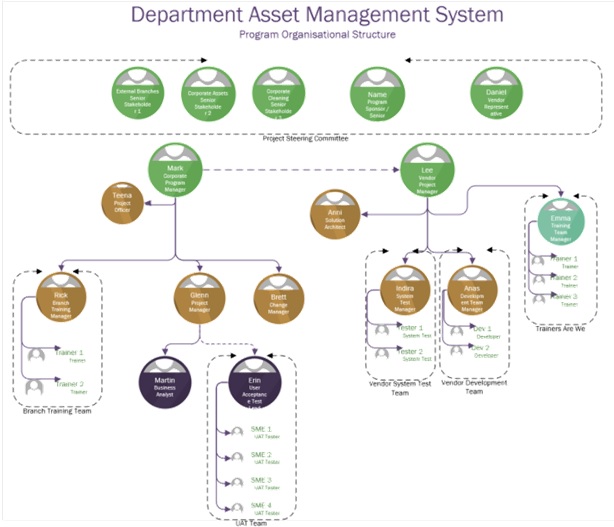
Corporate and Branch teams
The Staff, who are located at Head Office within their corporate teams, are primarily responsible for liaising and supporting the branch office staff, however, they are mainly called upon to report on KPIs and ensure that the projects which are created for each branch office, are delivered according to agreed requirements. For the purposes of simplicity, this report will focus on the impacted divisions within the Corporate Head Office location, along with their branches which are located in Metropolitan and Non-Metropolitan Regions across the state.
The Branch staff is responsible for their assets and their staff as well as their own customers. The Branches are the delivery arm of the department. While they manage assets and maintenance work at their own sites, they are also responsible for the delivery of the department services to their local communities. This Branch staff is also responsible for reporting back to the Corporate Divisions. The aim of DAMS is to reduce the amount of duplication in the preparation of these reports for the Corporate teams, using the data from a centralized base of information, which can be accessed, depending on securities and permission, by all staff who need to access the data.
The Corporate and Branch teams and their applications within DAMS are listed below in Table 1 Division and Applications. The Regional structure is shown in the map below in
Figure 2 Regional Divisions within Victoria
Table 1 Division and Applications
|
Corporate Division / Branch Responsibility |
Application |
Release date |
|
Asset Management | ||
|
Asset Register |
Release 1 – deployed | |
|
Agreements |
Release 1 – deployed | |
|
Disposals |
Release 1 – deployed | |
|
Acquisitions |
Release 1 – deployed | |
|
People and Culture | ||
|
People and Lists |
Release 1 – deployed | |
|
Corporate Finance / All branches | ||
|
Contractors |
Release 1 – deployed | |
|
Corporate Finance | ||
|
Investment Management |
Release 3 – no release date | |
|
Capital Allocation Tool |
Release 3 – no release date | |
|
Corporate Reporting | ||
|
Reporting |
Release 1 – deployed | |
|
Forecasting and Modelling |
Release 3 – no release date | |
|
Corporate Planning | ||
|
Asset Management Planning Modelling |
Release 3 – no release date | |
|
Corporate Planning / All branches | ||
|
Condition and efficiency management |
Release 3 – no release date | |
|
Asset Management Reform Implementation Team / All branches | ||
|
Property Condition Evaluation |
Release 2 - delayed | |
|
Capability Building Unit/ All branches | ||
|
Asset Maintenance Plan |
Release 2 - delayed | |
|
Corporate ESM Team / All branches | ||
|
Essential Safety Measures |
Release 2 - delayed | |
|
Response Programs Unit / All branches | ||
|
Asbestos Registers |
Release 2 - delayed | |
|
Safe Program |
Release 2 – delayed | |
|
Asbestos Management and Audits |
Moved to Release 3 | |
|
Cleaning Unit / All branches | ||
|
Cleaning |
Release 2 – delayed, part has been moved to Release 3 | |
|
Corporate Division / Branch Responsibility |
Application |
Release date |
|
Contractor Panel application and management |
Release 3 – no release date | |
|
Cleaning Audits |
Release 3 – no release date | |
|
All branches |
Work Order Management |
Release 2 - delayed |
Figure 2 Regional Divisions within Victoria
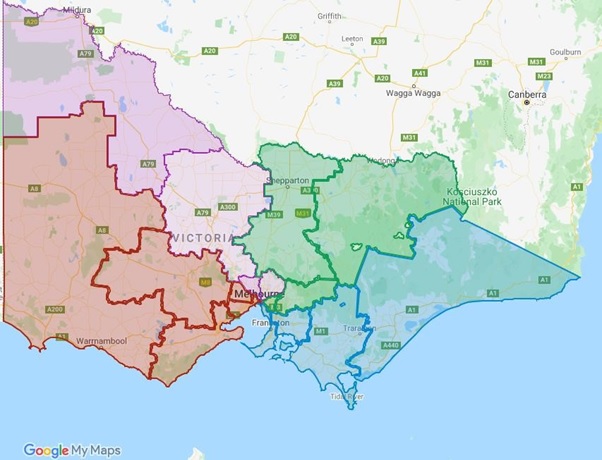
The product
The key benefits of DAMS are mainly aimed at the Corporate Management Teams, who are looking at the centralized reporting and centralized future planning options which will be delivered when the project has been completed. Several applications scheduled for Release 3 are aimed at achieving the future planning requirements. At this completion of Release 3, all of the applications will have been delivered and all staff, state-wide, will have been trained with some having used the applications for at least 12 months. The Corporate Reporting Team will be developing key reports to provide planning and modeling for future asset acquisitions and asset maintenance programs. These reports will feed future budget proposals which will be submitted to the Treasury Department in order to acquire future funding. The Forecasting and Modelling application will allow the Corporate Planning Team to utilize the key criteria set for funding of services to the community, on the basis of future planning of resident numbers in each Region This form of planning looks at a 10-year view into the future and is essential for the ongoing funding of services. The Corporate Reporting teams understand the need for this application, but it also requires the input of data that is maintained by other Corporate Teams, as well as data that is maintained by the Branch staff.
The Branch staff have supplied representatives for a Branch Reference Group, and have worked together for a number of years to identify their specific requirements and to agree on the terminology and the expectations of what they will see and how they will be able to view this data. The Branch Reference Group is aware of the need to supply data to all of the Corporate Teams, and continually feels pulled between the teams, as each team requires data from them throughout the year, often at the end of each quarter.
As part of the initial communications with Department Senior and Executive Management, expectations have been set regarding the way in which DAMS will benefit all of the department stakeholders, and in particular, how some of the key applications will be used and will be useful. It has recently come to light, that these expectations were not conveyed to the Subject Matter Experts or to the Project Team.
Non-Department Stakeholders
External stakeholders include the Training Team, Trainers Are We, who report to the Vendor Project Manager, Lee, and who have been engaged to supply training materials and provide training to key stakeholders within the Corporate Teams for each application as it is ready to be delivered. The Training Team has carried out a Training Needs Analysis very early in the project, and on the basis of this Training Needs Analysis, they have provided recommendations regarding the materials and training that will be developed. The Training Team is not employed by the Department and has not been able to meet with internal or external stakeholders of the Department. Therefore there is a lack of understanding of the current as-is processes which are followed within the department and specific teams and the Training Team are developing the materials based on their understanding of undocumented to-be processes, taken from the Solutions Specification Document.
The application solutions are under development by the vendor following workshops with selected Subject Matter Experts, who have been appointed by the internal Project Team. The workshops are facilitated by the Business Analyst, and the Solutions Architect, both of whom note all of their findings and their solutions into the Solutions Specification Document, This technical document is mapped back to the Tender Requirements Specification Document.
Program Governance
Mark meets weekly with the Vendor Project Manager (Lee), the Training Team Project Manager
(Emma), the Business Analyst (Martin), the Change Manager (Brett), and the internal Project Manager (Glenn). Mark reports monthly to the Project Steering Committee, which is chaired by the Project Sponsor.
The members of the Department Project Management Team have developed a schedule for requirement workshops, development of the solution, and development of training materials as well as training delivery. They have also listed the key milestones, which Mark uses as the basis of his status reporting to the Steering Committee.
The Training Team is able to communicate with the Solutions Development team in order to confirm their understanding of the applications and how the business will use these applications. They have identified that there has not been a process review of as-is processes, and the to-be processes can only be found within the Solutions Specification Document. No process maps have been supplied and they do not appear to have been developed. This has been raised with and requested of the Department Project Management Team on many occasions, with no positive outcomes.
Figure 3 Program Governance
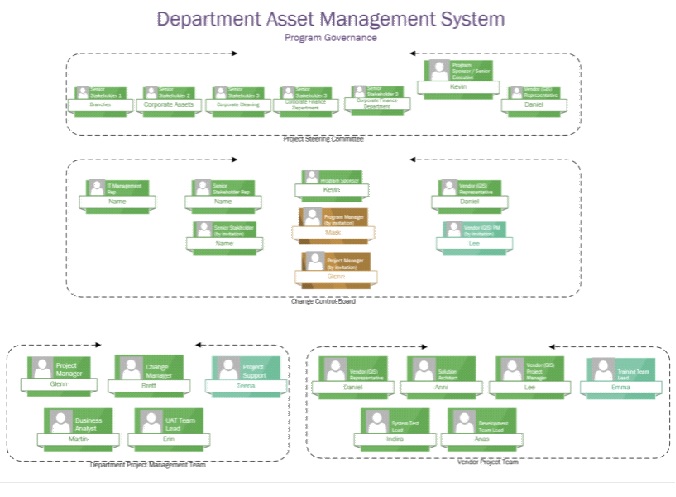
Schedule and Milestones
Release 1 was delivered late. The original release date was the end of August 2020. Corporate User Training was delivered in August and September with the final go-live date of the end of September 2020.
Release 2 has not been delivered yet. The original release date was March 2021. Training for each application has been delivered during March and April 2021. The go-live date was rescheduled to the end of July and has since been canceled. The release of applications to the Branches has been scheduled as a Pilot rollout, with the Branch training to be delivered by the Department’s Internal Training Team, headed by Rick. Rick is a Branch Manager who has been seconded to the Project, to deliver training to the Branches, and he is concerned that this must be successful as it may impact his career progression.
As Rick has been learning to use the applications and preparing the training materials to be used for the Branches, he has discovered that the applications do not contain the promised features, the terminology on the screens does not match that which was promised to the Branch Reference Group, and features which were to have been automated remain manual data entry. He is concerned as the requirements were gathered in conjunction with his branch colleagues, and he understands their needs and their concerns. Rick is concerned that his colleagues in the Branch Reference Group will not accept the DAMS system in its current format. He feels let down and embarrassed and is unsure of how he will deliver this training to the Pilot Branch Group. Rick needs to begin training soon and is not comfortable that his training will be well accepted once the Branch Managers realize that they are not going to receive the benefits that they have been promised.
Release 2 has also suffered a loss of confidence with the Corporate Teams who are completing User Acceptance Testing. As Release 2 approaches its go-live date, User Acceptance Testing is underway. The testing staff has been provided with a walk-through by the Vendor Training Team, and this was the first time that the Testing staff has seen the applications that they will be testing. They have been provided a testing script which they must follow in order to test the solution. These staff is finding that their expectations of what the DAMS system will do for them, and how it will do it for them, are not being realized, and the volume of discontent is becoming louder after UAT testing.
The Management of the teams receiving the new applications have not previously seen the solution, and they are beginning to express some concerns as they hear their testing staff comment and complain about how they are to use the new system. The UAT team members have found that the promised features are not in the current release, headings and field names are confusing and contain incorrect reference data, and the screens are not user-friendly, nor do they contain the data that is required. The Management staff, therefore, asked for a walkthrough of the new applications and were provided with a training session, during which they were taken through the step-by-step approach to using the application, and were provided with review scenarios to ensure that they have understood the application.
During these training sessions, the Management staff began to ask questions of the trainer, about how the system works and find that it is not delivering what has been promised to them. Questions about new processes and how these apply to their existing processes come to the fore during these training sessions. This is repeated in every training session and with different divisions of the department. The trainers are beginning to become frustrated as they find new information about expectations, but they have already completed the development of materials. The trainers also find that some features which should have been working, are now not working, as updates have been implemented.
Release 3 is due to be delivered in September 2021 and will be rolled out to the Branch offices beginning in February 2022. Training and go-live dates, however, have not been confirmed. Currently, many features of Release 2 have been deferred to Release 3, in an attempt to deliver Release 2 on or close to schedule, and there is an ongoing discussion between the Vendor and the Project Team, regarding the changes and increases in scope. Lee and Mark have had a number of strong discussions regarding requirements and the agreed specifications. Lee has escalated many of these issues to her Senior Management from a contract perspective.
Mark has left the project, suddenly and with no warning, in mid-May 2021 along with his assistant Teena.
Table 2 Scheduled Applications and Release dates
|
Application |
Release Number |
Notes |
|
Asset Register |
Release 1 |
Deployed |
|
Agreements |
Release 1 |
Deployed |
|
Disposals |
Release 1 |
Deployed |
|
Application |
Release Number |
Notes |
|
Acquisitions |
Release 1 |
Deployed |
|
Contractors |
Release 1 |
Deployed |
|
People and Lists |
Release 1 |
Deployed |
|
Reporting |
Release 1 |
Deployed |
|
Property Condition Evaluation |
Release 2 |
Delayed past July |
|
Work Management |
Release 2 |
Delayed past July |
|
Asset Maintenance Plan |
Release 2 |
Delayed past July |
|
Essential Safety Measures |
Release 2 |
Delayed past July |
|
Asbestos Registers |
Release 2 |
Partially moved to Release 3 |
|
Safe Program |
Release 2 |
Delayed past July |
|
Cleaning |
Release 2 |
Partially moved to Release 3 |
|
Asbestos Management and Audits |
Release 3 |
Delivery date not scheduled |
|
Capital Allocation Tool |
Release 3 |
Delivery date not scheduled |
|
Investment Management |
Release 3 |
Delivery date not scheduled |
|
Forecasting and Modelling |
Release 3 |
Delivery date not scheduled |
|
Asset Management Planning Modelling |
Release 3 |
Delivery date not scheduled |
|
Condition and efficiency management |
Release 3 |
Delivery date not scheduled |
|
Contractor Panel application and management |
Release 3 |
Delivery date not scheduled |
|
Cleaning Audits |
Release 3 |
Delivery date not scheduled |
A new Program Manager, Jenny, has just been appointed to replace Mark. She is hearing rumblings of discontent and has a number of meetings scheduled with Project Team Managers, the Corporate Team Managers, and the Branch Training Team Lead, Rick, who is liaising with the Branch Managers. Release 2 is on hold, and the training for the Pilot Branches has just been canceled. Jenny reviews the current Project Reporting dashboard (Appendix 2) before meeting the team.
Appendix 1 Rate Card
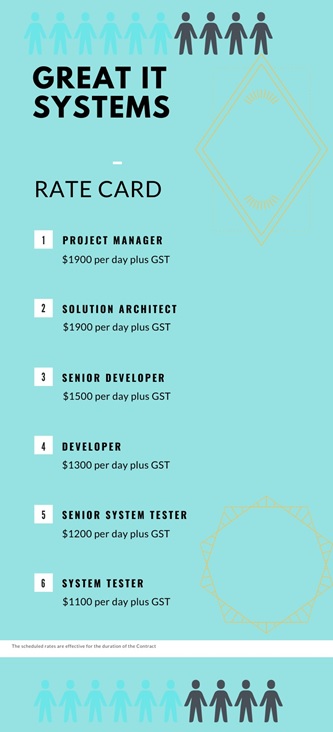
Appendix 2 Department Dashboard Reporting
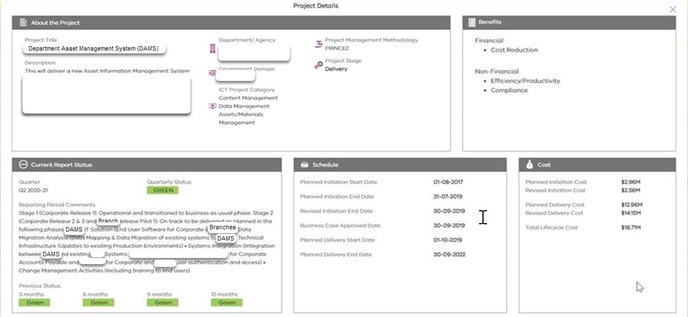
Resources
- 24 x 7 Availability.
- Trained and Certified Experts.
- Deadline Guaranteed.
- Plagiarism Free.
- Privacy Guaranteed.
- Free download.
- Online help for all project.
- Homework Help Services

